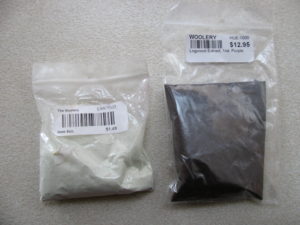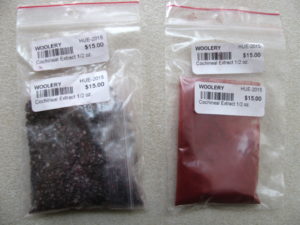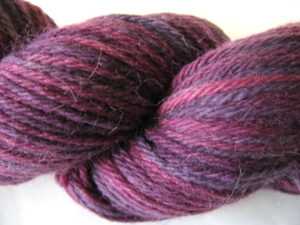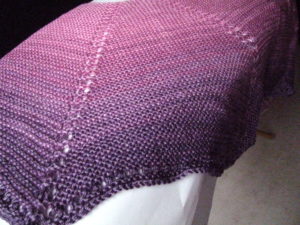When I first began dyeing with bits of nature, I focused on the black walnuts, apple bark, and pokeberries, that were in my yard. But even with black beans for blue, I wasn’t happy with the pinks and purples I made when trying to blend and modify these few natural ingredients.
So I looked into expanding the pallet by ordering a few items from an online store. I picked “Woolery” because it’s not only in the United States, but it’s also on the East Coast like me. Therefore, I reasoned that the shipping would be timely. And it IS!!! These folks are quick! My orders come within the week.
They are also friendly, if I have problems, or need to understand the dyes a little better. Their website is easy to navigate, and there is enough information about each dye so you can figure out how much to use. They also feature acid dyes, spinning products, yarn and fiber. Their web site is: http://www.woolery.com/store/pc/Dyeing-c17.htm
When you order these dyes, they come in little bags, double bagged in fact.
Cochineal comes in 2 forms. You can buy the little dried bugs on left, or the concentrated powder on the right. http://en.wikipedia.org/wiki/Cochineal is a decent web site and an interesting read about the history of their use and how they are farmed. The name comes from the latin word for scarlet. When I use the bugs, I grind them first in my coffee grinder. This works very well, and is completely sanitary because cochineal is also a natural food coloring!! How about that?!
I was shocked at how hard they are!! Chopping them didn’t work. Crushing them didn’t work. However, the coffee grinder does the trick. I have to be honest here…….3 years ago, when I first used my coffee grinder, I did not know the bugs were also used for food coloring. Nope. I have to admit that I was desperate and just used the grinder, washed it, and didn’t tell my husband. It was only about 6 months ago that I learned that it was actually perfectly fine. I know, I know, dumb.
The other powder I use is logwood.
 Logwood is a tree that grows in Mexico and Central America, so there’s no way I’ll find it near by.
Logwood is a tree that grows in Mexico and Central America, so there’s no way I’ll find it near by.
If you want to read about it, you can find a short, quick article about it here:
http://en.wikipedia.org/wiki/Haematoxylum_campechianum
The bag on the left is iron. I included it in the discussion here, because I have been using it in tiny amounts here and there. (It is also available at Woolery along with other natural dyes and mordants.) Adding iron to the dye bath makes the purple a bit greyer, but also more lightfast. Just like pokeberries, logwood needs a little help in that department. So I often use just a tad to help the color stay beautiful for a long time.
When you dye with them, it’s simply a matter of adding powder to the dye pot full of water, and stir until it has dissolved! Woo hoo! Easy. I love it. Not only that, but you can mix the 2 powders together!
Magentastic is made with pure cochineal:
Mystic Mauve is made with pure logwood:
And Pansy Purple is made by blending the two of them.
And when I make the gradient Purple Pizzazz, 3 blends of cochineal and logwood are featured! (This is the Meritime yarn)
I also use logwood and cochineal when I blend both colors on the same hank as in the Purple Pizzazz Woolpaca multicolored:
Here is the Weaver’s Shawl knit with one set of Meritime Purple Pizzazz gradient:
Lastly, here is a quick look at our new color: Winter Berries. This uses the 3 colors of purple/pink, plus 3 shades of blue.








